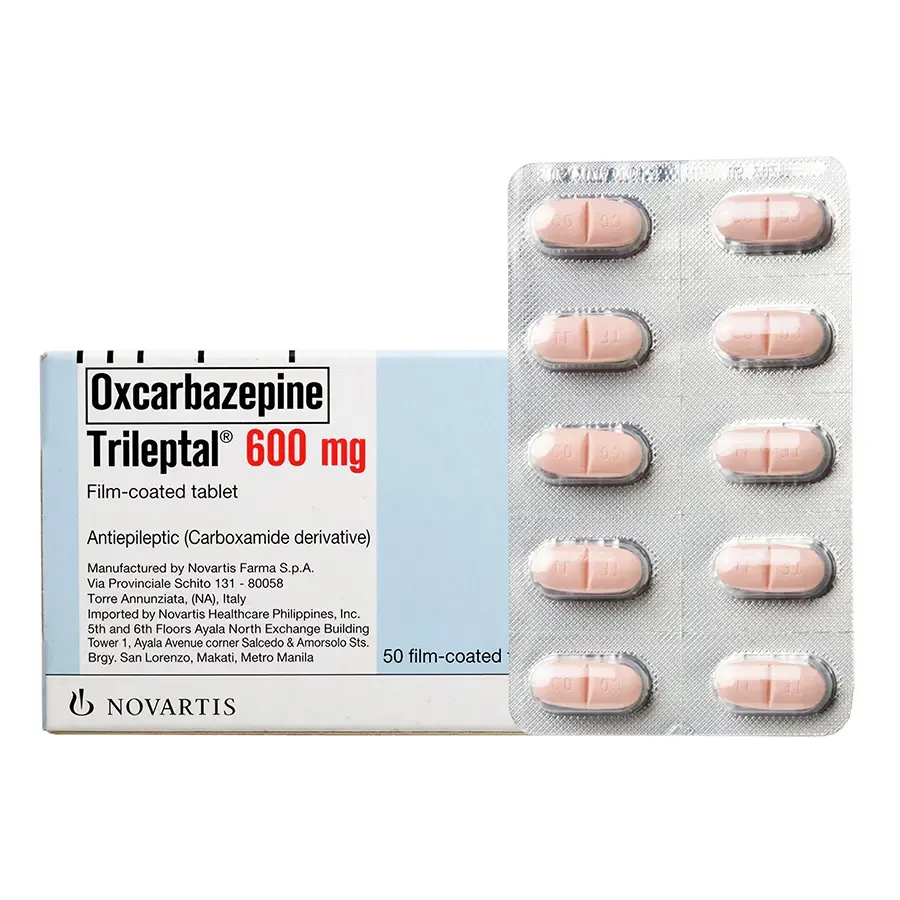Unit Price:
৳ 35.11
(5 x 10: ৳ 1,755.50)
Strip Price:
৳ 351.10
Also available as:
Indications
Trileptal is indicated for:
Adults: Monotherapy or adjunctive therapy in the treatment of partial seizures
Pediatrics: Monotherapy in the treatment of partial seizures in children 4-16 years. Adjunctive therapy in the treatment of partial seizures in children 2-16 years.
Adults: Monotherapy or adjunctive therapy in the treatment of partial seizures
Pediatrics: Monotherapy in the treatment of partial seizures in children 4-16 years. Adjunctive therapy in the treatment of partial seizures in children 2-16 years.
* রেজিস্টার্ড চিকিৎসকের পরামর্শ মোতাবেক ঔষধ সেবন করুন
Pharmacology
The pharmacological activity of Oxcarbazepine is primarily exerted through the 10-monohydroxy metabolite (MHD). The precise mechanism by which Oxcarbazepine and MHD exert their antiseizure effect is unknown; however, in vitro electrophysiological studies indicate that they produce blockade of voltage-sensitive sodium channels, resulting in stabilization of hyperexcited neural membranes, inhibition of repetitive neuronal firing, and diminution of propagation of synaptic impulses. These actions are thought to be important in the prevention of seizure spread in the intact brain. In addition, increased potassium conductance and modulation of high voltage activated calcium channels may contribute to the anticonvulsant effects of the drug. No significant interactions of Oxcarbazepine or MHD with brain neurotransmitter or modulator receptor sites have been demonstrated.
Dosage & Administration
Adults: initiate with a dose of 600 mg/day, given twice-a-day
- Adjunctive Therapy: Maximum increment of 600 mg/day at approximately weekly intervals. The recommended daily dose is 1200 mg/day
- Conversion to Monotherapy: withdrawal concomitant over 3 to 6 weeks;reach maximum dose of Oxcarbazepine in 2 to 4 weeks with increments of 600 mg/day at weekly intervals to a recommended daily dose of 2400 mg/day
- Initiation of Monotherapy: Increments of 300 mg/day every third day to a dose of 1200 mg/day.
- Creatinine Clearance <30 mL/min: Initiate at one half the usual starting dose and increase slowly
- Adjunctive Patients (Aged 2-16 Years): For patients aged 4 to 16 years, target maintenance dose should be achieved over 2 weeks. For patients aged 2 to <4 years, maximum maintenance dose should be achieved over 2 to 4 weeks and should not to exceed 60 mg/kg/day
- Conversion to Monotherapy for Patients (Aged 4-16 Years): Maximum increment of 10 mg/kg/day at weekly intervals, concomitant antiepileptic drugs can be completely withdrawn over 3 to 6 weeks
- Initiation of Monotherapy for Patients (Aged 4-16 Years): Increments of 5 mg/kg/day every third day
* রেজিস্টার্ড চিকিৎসকের পরামর্শ মোতাবেক ঔষধ সেবন করুন
Interaction
In vitro and in vivo studies showed little or no interaction of Trileptal with cytochrome P450 enzymes. Since Trileptal is used as adjunctive therapy, trials of Trileptal given concomitantly with other antiepileptics explored the effects of Trileptal on others antiepileptics. No drug interactions with cimetidine, dextropropoxyphene, erythromycin and warfarin.
Contraindications
Oxcarbazepine is contraindicated in patients with a known hypersensitivity to Oxcarbazepine or to any of its components, or to eslicarbazepine acetate.
Side Effects
Clinical trials show that Trileptal is better tolerated than carbamazepine. The most common adverse effects were: Central nervous system: dizziness; diplopia; headache, nystagmus; abnormal gait; GI: nausea; vomiting; abdominal pain; Dermatologic: rash; Serum electrolytes: hyponatremia. Bone marrow suppression and hepatotoxicity, associated with carbamazepine, were infrequently reported with Trileptal.
Pregnancy & Lactation
Pregnancy Category C. There are no well-controlled clinical studies in pregnant women. Oxcarbazepine should be used in pregnancy only if the potential benefit justifies the potential risk to the fetus. Oxcarbazepine is excreted in the human milk. A milk-to-plasma concentration ratio of 0.5 was found. So, Oxcarbazepine is not to be used during breast feeding.
Precautions & Warnings
Cognitive/neuropsychiatric events (psychomotor slowing, difficulty with concentration, language problems, somnolence or fatigue, ataxia and gait disturbances) were some of common adverse effects associated with Trileptal. Cases of asymptomatic hyponatremia were reported. Monitoring of serum sodium levels should be considered if the patient is on other medications known to decrease serum sodium levels or if symptoms of hyponatremia (nausea, malaise, headache, confusion) develop. Patients with a hypersensitivity reaction to carbamazepine should be treated with Trileptal only.
Therapeutic Class
Adjunct anti-epileptic drugs
Storage Conditions
Store at temperature not exceeding 30°C in a dry place. Protect from light and moisture.

